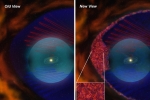Skeleton Found By Cave Divers Estimated To Be One Of The Oldest In North America

A cave-diving team found the remains of the sixth oldest skeleton found in the Americas, which links her ancestry with the earliest Americans to today's modern Native American, unraveling another clue to our human history. The story and details on the discovery of the well-preserved teenage skeleton, who they've named "Naia," will be published May 16, in the journals of Science.
Like Us on Facebook
Her remains were found in an underwater Yucatan Peninsula bell-shaped cave structure in a large pit named Hoyo Negro in Mexico. The center was littered with large boulders stacked on top of each other, and there the skeletal remains sat seemingly waiting to be discovered. Her pelvic bone was shattered and the break was dated back to the time of her death, which has led scientists to believe she plummeted to the bottom of the cave where she remained trapped for thousands of years.
"The preservation of all the bones in this deep water-filled cave is amazing -- the bones are beautifully laid out," said Patricia A. Beddows, the department chair of Earth and Planetary Sciences in Northwestern's Weinberg College.
"The girl's skeleton is exceptionally complete because of the environment in which she died -- she ended up in the right water and in a quiet place without any soil. Her pristine preservation enabled our team to extract enough DNA to determine her shared genetic code with modern Native Americans, " Bellows added.
The mitochondrial DNA was the key focus of the DNA extracted from the ancient female human remains in three independent laboratories with help and collaboration from National Geographic, the University of New Mexico, Stanford University, and many more. Mitochondrial DNA is only inherited down the female line, which means that although males receive their mother's mitochondrial DNA, he cannot pass it onto his own children. It has been affectionately nicknamed "the Eve gene" as it is passed down from great grandmothers, down to their daughters and so on, which creates a trail of crumbs for scientists to trace back deep into our history.
Naia's mitochondrial DNA led scientists back 12,000 to 13,000 years ago to the D-1 lineage, which traces her ancestry back to the source population as contemporary native Americans. Her teeth were analyzed, which is what determined that she belonged to D-1. Her maximum age is 13,000-years-old but the carbonate crystals that grew on her bones could make her at earliest 12,000-years-old. The lineage is thought to be developed after the ice age occupancy became genetically isolated and doesn't indicate an early migration from a part of the world different than from where the Native Americans reside.
"On one hand we have a large team of scientists who have been extremely generous, sharing their knowledge and experience to analyze, understand, and interpret the findings in order to produce the knowledge we have gotten so far," said James Chatters, a forensic anthropologist and archaeologist and owner of Applied Paleosciences. "On the other hand, there's the cave divers who have been taking specialized courses to gather data for archaeological purposes to properly take samples, measurements, etcetera, with extreme care."
Because her remains are so well intact, Naia was a goldmine for archaeological discovery but the threat of unauthorized divers damaging the bones pressured researchers to remove her from the site. Five pieces of Naia were recovered and brought to their lab this past March, including clavicle, humorous, and the invaluably unscathed skull.
"Research in flooded caves is much like space exploration, with divers similar to astronauts reporting back to 'mission control' -- a much larger scientific team at the surface," Beddows said. "It all has to be done on scuba, which is our life support system. Our science team has been supported by a great number of dedicated non-science cave divers who have committed hundreds of hours at very dangerous depths to complete this exploration."
Beddows is one of the members of the international team of researchers who explored the caves after divers alerted the Mexican government's National Institute of Anthropology and History. One of the researchers believes a new approach to underwater discovery needs to be implemented because of the limits they were faced with as scientists. The researchers were moderately good scuba divers, however they couldn't go as far and deep as the team of professionals, which suggests more training programs are needed in order to expand research efforts.
One of the first to see Naia reports on the memorable encounter: "We knew it was an incredible place the moment we were inside. The floor disappeared under us and we could not see across to the other side. All we could see was the darkness and we reached the floor about 170 feet. As our eyes got accustomed to the environment, we started to notice large animal bones. The first we found was a 3-foot femur resting against one of the boulders. My teammate started pointing to the other animal remains resting at the bottom and the walls of the peak.
"He pointed to a human skull resting in top of a small ledge. It was a small cranium laying upside down, with a perfect set of teeth and dark eyes. The skull rested on the humorous and we could see the torso spread to the left and down on the legs. We eventually named the skeleton 'Naia,' which is the Greek reference to a water name. We reported the sight to archaeologists and together we created the goal to work together to unravel the mysteries."
Naia is now the most completed skeletal structure from this early group of humans found in the Americas and will allow researchers to chronologically place her and her lineage in the timeline of human history.
"This is fascinating and a wonderful story to be engaged in. I believe in the story of Lucy from where I originated myself and Naia's story touches. I believe in our hunger for deep human connection in space and time. So I feel very fortunate that my lab was involved in this project," one researcher from Mexico said.
Lucy is a 3.2 million-year-old female skeleton discovered in Ethiopia in 1974. Her bone structure shed light on the development of human's big brains and the time we took our first upright steps, which makes her the oldest hominid on record to do so. The discovery of Naia will add one more piece to our largely enigmatic human genometric puzzle.
© 2012 iScience Times All rights reserved. Do not reproduce without permission.

25 Year Study Reveals Eco-Farming To Be Economically Feasible And Sustainable

How Methane-Producing Microbes Caused The Largest Mass Extinction The World Has Ever Seen

Terrifying Animatronic Robot Dances To 'Blurred Lines,' Causes Nightmares [VIDEO]

Scientists Demonstrate Three-Way Quantum Communication: What's Faster Than The Speed Of Light?

Woolly Mammoth DNA To Be Cloned, Then Joined With Elephant DNA To Create New Creature

Oculus Rift Headset Will Take You On A Trip To Space, All From The Comfort Of Your Couch



![How to Turn Your Tap Water Faucet Into a Coffee Spout [VIDEO]](../../../cdn-sub/data/thumb/mainpage/6005-150100-coffee.jpg)

